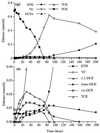Reductive dechlorination of chlorinated ethenes and 1, 2-dichloroethane by "Dehalococcoides ethenogenes" 195
- PMID: 10388710
- PMCID: PMC91463
- DOI: 10.1128/AEM.65.7.3108-3113.1999
Reductive dechlorination of chlorinated ethenes and 1, 2-dichloroethane by "Dehalococcoides ethenogenes" 195
Abstract
"Dehalococcoides ethenogenes" 195 can reductively dechlorinate tetrachloroethene (PCE) completely to ethene (ETH). When PCE-grown strain 195 was transferred (2% [vol/vol] inoculum) into growth medium amended with trichloroethene (TCE), cis-dichloroethene (DCE), 1,1-DCE, or 1,2-dichloroethane (DCA) as an electron acceptor, these chlorinated compounds were consumed at increasing rates over time, which indicated that growth occurred. Moreover, the number of cells increased when TCE, 1,1-DCE, or DCA was present. PCE, TCE, 1,1-DCE, and cis-DCE were converted mainly to vinyl chloride (VC) and then to ETH, while DCA was converted to ca. 99% ETH and 1% VC. cis-DCE was used at lower rates than PCE, TCE, 1,1-DCE, or DCA was used. When PCE-grown cultures were transferred to media containing VC or trans-DCE, products accumulated slowly, and there was no increase in the rate, which indicated that these two compounds did not support growth. When the intermediates in PCE dechlorination by strain 195 were monitored, TCE was detected first, followed by cis-DCE. After a lag, VC, 1,1-DCE, and trans-DCE accumulated, which is consistent with the hypothesis that cis-DCE is the precursor of these compounds. Both cis-DCE and 1,1-DCE were eventually consumed, and both of these compounds could be considered intermediates in PCE dechlorination, whereas the small amount of trans-DCE that was produced persisted. Cultures grown on TCE, 1,1-DCE, or DCA could immediately dechlorinate PCE, which indicated that PCE reductive dehalogenase activity was constitutive when these electron acceptors were used.
Figures






References
-
- Ensley B D. Biochemical diversity of trichloroethylene metabolism. Annu Rev Microbiol. 1991;45:283–299. - PubMed
Publication types
MeSH terms
Substances
LinkOut - more resources
Full Text Sources
Other Literature Sources

